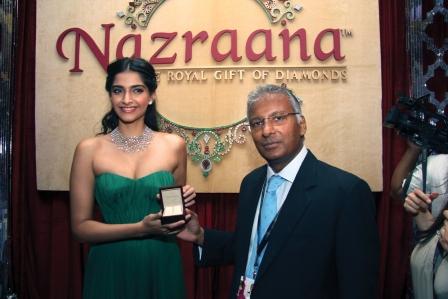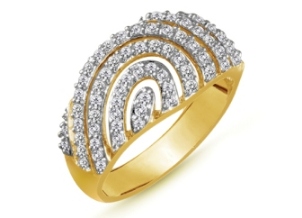Forget The Bride – Here Come The Rest!
February 06, 13
It started as a clever idea to get the large volume of off-color and brown diamonds from Rio Tinto’s Argyle mine moving by tapping into India’s gigantic bridal market. A year on, Nazraana, the umbrella diamond jewelry brand that grew out of the marketing idea, has taken off and has now even made inroads to India’s festival-driven market.
 Image: Rio Tinto Diamonds |
The bridal market is the primary sales driver for jewelry sales in the country for the one very good reason: at every economic level, Indians spend lavishly on weddings – and a great many Indians get married every year.
Vikram Merchant, manager of Rio Tinto’s India Representative Office estimates that 10 million weddings take place every year in India “We estimate the Indian wedding as an institution to be worth $25 billion (Rs.1.35 trillion) annually. We also estimate that they generate $11 billion (Rs.600 billion) in bridal jewelry sales every year.”
Merchant says that expenditure on weddings is so heavy that they have become the fourth-largest contributor to the country’s gross domestic product (GDP) after services, manufacturing and agriculture. “Jewelry retail in India is simply part of the bridal service industry,” he observes.
Traditionally, the bridal market has been the sole preserve of gold jewelry but diamonds have made strong inroads over the last decade or so. This should then have been an automatic growth market for Rio Tinto, but there was a catch. The diamonds in the jewelry the bride wears tend to be larger, higher quality stones and the output from the Argyle mine consists predominantly of small, off-color and brown stones.
Rio Tinto realized that the bridal market itself did not offer the opportunity they were looking for, but that didn’t mean that weddings did not provide an untapped resource.
“We took another, close look at the market,” Merchant says, “and we realized that apart from the jewelry for the bride herself, the occasion provided a huge opportunity for affordable diamond jewelry in the heavy gifting that is associated with the Indian wedding.”
These gifts – to in-laws, family elders and the near and dear – which are mandatory at a wedding, traditionally come in the form of saris, suiting material - and gold and silver.
Merchant says that the company asked why the jewelry given at weddings could not be diamond jewelry that would fall in the same price bracket as the saris and suit-lengths as well as the gold and silver bars and biscuits. Fortunately, the output from Argyle was just the sort needed to manufacture diamond jewelry in this gifting price bracket. What emerged as a result was Nazraana.
 Actress Sonam Kapoor, The Brand Ambassador For Indian Diamond Jewelry, With Rio Tinto's Vikram Merchant |
“The name connotes the tribute paid to Moghul rulers and fitted the concept like a glove,” says Merchant. “The couple is the king and queen on their wedding day and diamonds are a gift fit for royalty.” Nazraana is not a brand, he explains, but a concept. “It’s the sort of diamond jewelry that is just right for the bridal gifting market. It’s affordable – it ranges between $92 (Rs.5,000) and $643 (Rs.35,000) – and because these are natural diamonds, Nazraana conveys real value to the recipient of the gift.” Rio Tinto’s market research indicated that any diamond jewelry in the $220 (Rs12,000) to $276 (Rs.15,000) price range would be in the “sweet spot” for this segment.
Rio Tinto worked with its diamond manufacturing clients, who either had jewelry fabricating operations of their own or worked closely with a jewelry manufacturer, and developed a concept for the bridal gifting market.
“With a minimum of 0.30 to 0.40 carats of diamonds and two or three grams of gold, Nazraana provides a great option for someone looking to buy wedding-related gifts,” Merchant says. The company also decided not to develop a distinct brand and a distinct retail system but opted instead to work with the vast network of established jewelry retailers across the country.
The company’s market study revealed that the average consumer believes that affordable diamond jewelry could not be bought at the family jeweler. At the same time, it turned out that the consumer also believed that the family jeweler is the only one who actually sells “real” jewelry. The family jeweler is the one a consumer will go straight to when jewelry has to be bought for a wedding.
“The actual wedding jewelry purchases are all high value,” Merchant observes. “This isn’t a fixed price bracket but relative to what the individual can afford. And this won’t be done anywhere but at a trusted jewelry retailer’s. No brand or label has got a serious look into this market.”
Nazraana’s opportunity comes when the high-value purchases are done. “Usually, the customer then has to go to a variety of product outlets to consider the gifting options. But now, right there, where the main wedding jewelry has been bought, the retailer, who knows the value of the customer’s main bridal jewelry purchases, can offer a range of diamond jewelry options that he gauges will fit the customer’s overall wedding budget. If the main bridal purchase has been in the millions, he can show Nazraana options at the top end of the bracket and of course the other end of the spectrum if the customer’s budget is limited.”
Merchant thinks the idea opens up a range of possibilities for retailers. “Think about it,” he says, “right after you’ve made some high-value sales, here’s an opportunity to sell perhaps 20 more pieces of affordable jewelry.” He adds that the idea, while specifically targeting the wedding-related gifting market, has the potential to grow into a generic gifting option for all sorts of occasions. “For the same price as an iPod, you can get really nice diamond jewelry; something that will hold its value and won’t grow obsolete.”
According to Merchant, one of the benefits of the Nazraana idea is that it frees the retailer from having to develop a specific buy-back policy for this sort of jewelry. “What the buy-back policy would be was one of the first questions they all asked us“We explained that they didn’t have to worry about a buy-back policy for a product that was specifically intended for the gifting market.”
 Image: Rio Tinto Diamonds |
Nazraana is now available in 145 stores in 43 cities across India. This is mostly in the north and eastern regions, but also in several Mumbai outlets.”
“Having launched Nazraana in 2011, I am pleased to see that retailers who entered the program at the outset are still very much with it and continue to re-order and support it,” says Merchant.
He says the support is visible through the counter space and in-store branding that is made available for Nazraana. “The only reason a retailer would give such an in-store presence to the brand is if this is translating into sales. In this regard, the Nazraana products are achieving steady year round sales. Again, the reason for this is the attractive, diamond-heavy design and pricing. For stores that cater to more affluent communities, Nazraana is often purchased as a gifting option, but it is achieving good sales in all stores as an entry point into diamond jewelry.”
Merchant reports that Nazraana’s move into generic gifting now appears established. Referring to jewelry sales over the Diwali festival in November 2012, he says that retailers reported that diamond jewelry outsold the plain-gold variety. “Our Nazraana sales also did extremely well wherever we conducted promotional events. Retail stores that participated in our Durga Puja [a festival – particularly popular in West Bengal – in which the goddess Durga is worshipped] promotion in Bengal reported Nazraana sales of up to 200 pieces for the month-long offer period.”
He thinks that Nazraana’s biggest achievement is in creating an entry point for consumer aspirations to own diamond jewelry. “What we are seeing is that though weddings and festivals are the purchasing occasions for jewelry, the driver, at least for diamond jewelry, is strongly aspirational. The purchase may well be justified as being an investment, but the reason to buy is aspirational – raising esteem and elevating the buyer to a new level of sophistication. This is particularly true in India for the growing middle class and wealthy rural communities.”